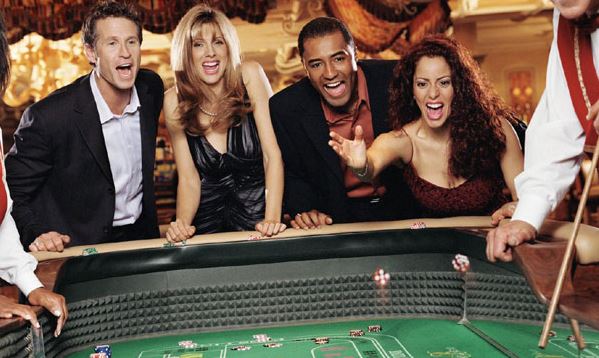The first look at a dice table is highly intimidating. However, most people understand, the person with their hot hands on the dice is the one in control. The thrill of your energy affecting the outcome of an event might be the reason playing dice is so popular. No one really knows, but shooting dice has an energy like no other game and it is fun.
The person shaking those square ivory pieces is called the shooter. However, if you have never played you are in total confusion. Yet, the energy of the game draws you and makes you want to understand the excitement.
During a game, people are placing bets, someone else is throwing dice, and it all looks a bit wild and chaotic. Nevertheless, this form of play has an organized beginning with a sensible outcome. I hope that means you win money, but then it might not.
Dice involves a lot of luck or it might bring geometry into play so, if you paid close attention in class, you might throw a fair pair of dice. At any rate, once you understand the game and get your roll going, the fun begins.
Start with understanding the playing field, which in this case is the crap table. It looks a bit like a pool table but has lines drawn on it for fields of play. At the head of the table is the pass line where the dealer stands. It is possible to place a bet in numerous positions around the table but let us take it slowly.
Types of Bets
- Come & Don’t Come Bets
- Place Win
- Odd bets
- Place Lose
- Pass Line & Don’t Pass Wagers
- Lay
- Buy
- Big 6 and Big 8
Beginners may use the Pass Line & Do not Pass Wagers for play. The latter is the most commonly placed bets in the game of craps. It is also, the simplest form of betting in the game.
The play in craps goes around the table in the direction of a clock. The game begins in two phases: Come out and point. Every player has the opportunity to roll the dice if they want it. However, it is not mandatory that players roll the dice. They simply bet on the play of others.
Now, in the beginning, the process of rolling there is one or more come-out rolls. This is the initial roll. If a player rolls 7 or 12, they will continue to have control of the dice and this is a win.
However, if they should roll a point number or a designated number on the board then they lose. Dice then are forwarded to the next player. Dice are rolled at the end of the dice table. The loss of play is termed, rolled out.
Players are able to continue rolling after crapping out, however, it is only necessary to pass the dice if a player rolls the number seven after the point is set up. People hear players in casinos and in movies yelling 7 and 11. These are natural. In essence:
Don’t Pass is a loss, “Pass line” wins. Of course, there are other numbers on dice considered point numbers: 4, 5, 6, 8, 9, and 10. A beginner can play once they get the don’t pass and pass line rules and the come and don’t come wagers, and of course the odds bets.
Pass Line and Do not Pass Wagers
If a player rolls 7 or 11, they win. However, if the show is 2, 3, or 12 they lose. If any other number shows, that number is recognized as a point value.
The pass line wager still sits on the table, contingent upon point being rolled once more, or until 7 is rolled. If the point comes first the wagers win: if 7 shows up first, the wager loses. In some instances, there is a tie or no winner no loser. This happens when the number value is 12.
The rule is the wager remains if a value is set. When and if the point is rolled, don’t pass loses. If lucky 7 shows the don’t pass wins. The don’t pass line is betting against the pass line. In essence, they are saying the number searched for will not happen.
Come and Do Not Come Bets
The wagering system works almost the same as pass line-don’t pass. You roll the value is set and if you roll f you lose. The biggest difference is the bet is placed after the value become evident, but not before the roll.
If you are lucky and get a 7 or 11, you win. If on the other hand, you get 2, 3, or 12 you take a loss. However, if any of the other numbers are rolled, the wager stays and if you are fortunate and the set value or point number is rolled once more; you win.
Now, a Don’t come bet is very similar to a don’t pass, only opposite. If on the first roll, a 7 or 11 appear, the player loses. You, however, win, if a 2 or 3 shows. Other numbers establish your special signature don’t come wager. If that point value shows, it stays in play and your bet will win if 7 shows and fail to be fruitful if the point shows. Both bring even money.
Odds Bets
Odds bets are similar to extending your winning or losing possibilities, a bit like adding extra insurance just in case things get a little shaky. If you win, the increase is nice but if you lose, it may not hurt so much. This side action is placed after the value is established. The odd bets are additional to the Pass and don’t pass or the ‘Come and do not come bets’. There are four of these extensions:
- Come Odds
- Don’t Pass Odds
- Don’t Come Odds
- Pass Line Odds
The house edge is nonexistent with these bets. A roll wins if the point is rolled before 7. The bet gives the winner true odds while winning amounts change with point values.
On a table when the puck is sitting in the off position, a game is in play and no bets are taken. When playing craps, it is important you tell the dealer if you want a bet to stay active. Watch the dealer and where the bet is placed. As always, never play with the grocery money. Have fun.


